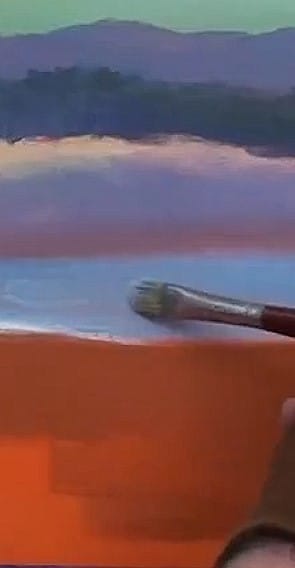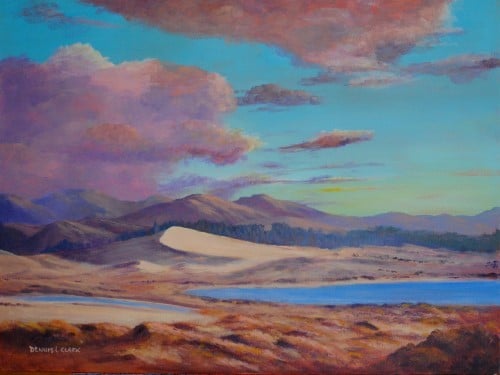Short Class Video
Class Tutorial
Painting the background

An orange background is going to be used for this painting. Set out some orange and pour out some Fastfix Medium (you also may use water) and mix.

The orange background almost completed. Dry after it is finished.
Paint the sky

Add some Dioxazine Purple to the orange and you get a brownish purple. Set out some Phthalo blue and White. Start adding the blue slowly to the white and build up the tone until the right tone is reached.

Carefully paint the blue as per the reference photograph. This method is called the complementary (opposite colour) painting. The idea here is to paint the blue over the orange in such a way that visibly the orange can just be seen. Most viewers will not see the orange, but the effect is very vibrant.
Paint the clouds

Add some White to the Orange, just enough to make a nice light pink colour.

Paint in all the bright cloud areas with a pastry brush. Then, with the purple colour, previously mixed, paint the darker shades of the clouds.

The various shades are nicely shown here. The top clouds are always nearest to you and normally the darkest. Notice the lovely glow to the clouds on the left.

Finalizing the late afternoon cloud effects.
Paint the mountains

The Purple mix for the mountains is made up by adding Dioxazine Purple into the Phthalo Blue and then adding just a touch of Orange to tone it down a bit.

Make the purple a bit lighter for the distant hill.

Using various tones (values) of the purple mixture, paint the distant hills as shown. Add the shadow for the main sand dune.
Trees and lagoon

Add the distant tree mass with a dark green. With a light blue, block in the lagoon.
Sand dune

Use White plus a touch of Yellow Ochre for the sunlight on the dune. A few streaks of purple to the right to add shadows on the sand. Paint a light strip of highlight colour for the shore line.

Paint the dune section to the left using the same colours
The foreground

The various browns are mixed from the orange and the blues – from dark brown to light brown.

Begin blocking in all the mound’s shadows first. This anchors them. Don’t try to count every one. Just get them more or less similar. For perspective, they get smaller as they recede into the distance.

Once you have established all the main shadows then, with a light brown mix, add the highlights above the shadows. Be careful to keep the highlight in the correct position.

Add some tones (values) to the nearer mounds for texture.

Add some small details to the distant dune. Highlight part of the shore line.
Finishing touches

Touch up some minor highlights to the cloud billows.

A few subtle clouds in the distance.

Lightening up the top cloud a bit. It was a bit too “heavy”.
Final painting

Click the button below to view the real time follow along version of this class:
Pin Me

